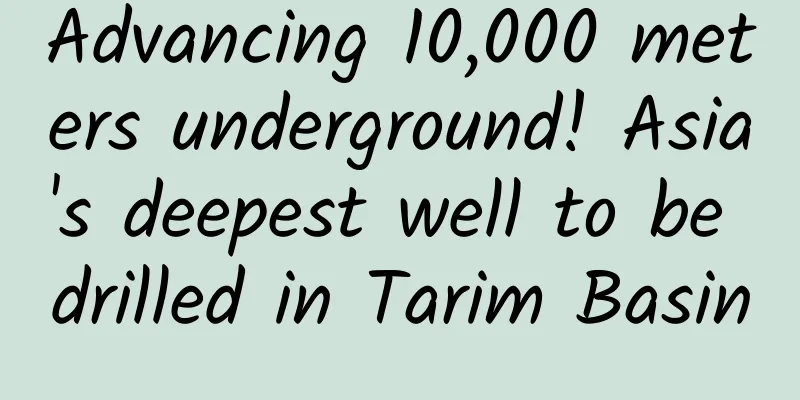Advancing 10,000 meters underground! Asia's deepest well to be drilled in Tarim Basin

|
On the edge of the Taklimakan Desert in Shaya County, Aksu Prefecture, Xinjiang, drilling of the Yuejin 3-3 well, the "Deep Earth No. 1", a key oil and gas project in my country's first "Deep Earth Project", officially started on the morning of May 1. The designed depth of Yuejin 3-3 well is 9,472 meters, which will break the record of the deepest well in Asia and provide core technology and equipment reserves for my country to enter the 10,000-meter deep well. According to the plan, this well will be drilled to the predetermined location within 170 days. How is the on-site preparation of "Shendi No. 1"? Let's take a look at the report of CCTV reporters on the scene. CCTV reporter Gu Junling: The Yuejin 3-3 well of the "Shendi No. 1" will officially start drilling. On the platform at the wellhead, the staff are already in place and are carrying out the final preparations before drilling. Zhou Yuru, an engineering technician at the "Shendi No. 1" Yuejin 3-3 well: I am feeling both nervous and excited right now. I am ready to go all out this time and I believe our team can successfully complete this mission. "Deep Earth" has become the main battlefield for oil and gas discovery in my country Going up to the sky, going down to the earth, going down to the sea, and reaching the summit are the four great feats of human beings to understand and feel nature. Compared with going up to the sky, going down to the sea, and reaching the summit, we are relatively unfamiliar with going down to the earth. Engineering projects carried out underground are currently the only means for humans to obtain underground information, and its difficulty is no less than that of space engineering. The well to be drilled in the Tarim Basin is part of the Chinese exploration of the earth. But it is not isolated. In the entire Taklimakan Desert, there are currently 120 wells with a depth of more than 8,000 meters. These wells have one mission, which is to drill out the oil and gas resources buried thousands of meters deep in the desert. This mission is also called deep earth engineering. According to international practice, generally speaking, a well with a depth of 4,500 to 6,000 meters is considered a deep well, 6,000 to 9,000 meters is considered an ultra-deep well, and more than 9,000 meters is considered an extra-deep well. The planned location of the Shendi No. 1 well to be drilled is 9,472 meters, making it an extra-deep well. The depth of this extra-deep well is equivalent to hundreds of meters higher than the height of Mount Everest. At present, "Deep Earth" has become the main battlefield for oil and gas discovery in my country. Oil and gas resources are mainly distributed in seven basins, namely Tarim, Ordos, Songliao, Bohai Bay, Sichuan, Junggar and Qaidam. However, unlike the situation in the Middle East, more than one-third of my country's known oil and gas resources are distributed 4,500 meters underground, and some are even deeper. In the Tarim Basin, more than 80% of the oil is buried in ultra-deep strata below 6,000 meters. Qi Lixin, chief expert in oil and gas exploration at Sinopec Group: my country's oil and gas resources in the middle and shallow layers have entered a highly mature stage, but deep strata still contain abundant oil and gas resources. Deep and ultra-deep oil and gas resources amount to 67.1 billion tons of oil equivalent, and have become the main battlefield for my country's oil and gas resource exploration. The oil and natural gas resources in the Tarim Basin at depths between 6,000 and 10,000 meters account for 83.2% and 63.9% of the total respectively. Currently, 60% of the world's newly added oil and gas reserves come from deep strata on land, and the potential for deep oil and gas exploration is huge. How difficult is it to extract oil from deep in the Tarim Basin? During the Cambrian period 500 million years ago, the Tarim Basin was still called the Tarim Sea. Billions of years of vicissitudes have caused the carbonate strata deposited in the ocean to be buried thousands of meters underground, slowly forming oil and natural gas. The geological conditions of the Tarim Basin are completely different from those of other basins in the world. The geological structure is complex and diverse, and oil and gas reservoirs generally face exploration and development difficulties such as ultra-deep, ultra-high temperature, and ultra-high pressure. When drilling wells in the Tarim Basin, after the drilling reaches a certain depth limit, the difficulty increases exponentially with each meter down. Unlike ground construction, the deeper the depth, the more difficult it is. Exploring and developing oil deep in the Tarim strata is no less difficult than "Chang'e" landing on the moon or "Jiaolong" going to the sea. For the oil industry, it is necessary to have the ability to "find" oil as well as the ability to "get" oil. To "get oil", it is necessary to build a "highway" between the surface and underground oil and gas reservoirs through drilling operations to allow oil and gas to flow. However, it is not easy to build a "10,000-meter road". Currently, there are not many countries that have the ability to drill 10,000 meters deep, mainly China, the United States and Russia. CCTV reporter Gu Junling: I am currently in the Shunbei Oilfield operating area in the Tarim Basin. When the well is drilled to a depth of 9,000 meters, the bottom temperature is about 200°C and the formation pressure is over 150 MPa. Among the 13 indicators used to measure the difficulty of drilling in the world, the Tarim Basin ranks first in 7 of them. More than 1,000 drill pipes need to be connected at a depth of 9,000 meters. Due to the high temperature and pressure, the drill pipes are like "cooked noodles" and are difficult to control. At the same time, facing the high temperature of about 200°C, the electronic components and rubber parts in general equipment and instruments will be damaged and fail, and the "navigation" system on the drill bit will also fail, making it difficult to accurately reach the target location. Wang Long, Party Secretary of Sinopec Northwest Oilfield Petroleum Engineering Technology Research Institute: Through collective innovation and research, we have explored and formed a set of complex ultra-deep wellbore structure design and supporting technologies that are among the best in the world, established a series of standards and specifications, and achieved breakthroughs in my country's key core technologies. The drilling cycle has been reduced from 280 days three years ago to a minimum of 97 days, and the target accuracy has been increased from 60% to more than 90%. (Reporter Zhang Wei and Huang Hong from the Xinjiang TV station) |
Recommend
2022 Nobel Prize in Physics: Indecision, quantum mechanics, the magician of the microscopic world
The 2022 Nobel Prize in Physics was announced at ...
Wearing black underwear makes you more likely to get cancer? The truth behind "Don't buy black underwear" is revealed
Black is one of the most common colors in textile...
This vegetable, which many people love to eat, is really not recommended to be eaten with rice, because...
Potatoes are a classic "side dish" that...
How to attract traffic to Toutiao today? Violent traffic diversion methods for headlines
When it comes to traffic, we naturally think of D...
Huawei is determined to enter the notebook industry: Who is the target of MateBook?
The Barcelona Mobile World Congress (2016 MWC) wi...
When it comes to dealing with tricky bugs, what’s the difference between novices and experts?
[[204255]] Problem description: Since last week, ...
Practical Tips: Four New Trends in Mobile Game Promotion in 2015
Last week, AppLift attended PGConnects in London,...
China Association of Automobile Manufacturers: A brief analysis of the production and sales of new energy vehicles in January 2022
According to statistics and analysis by the China...
Can Bilibili become the fourth pole of live streaming e-commerce?
During the Mid-Autumn Festival that just passed, ...
A collection of words used by marketing planners (worth collecting)
In the marketing circle If there is no profession...
Do you remember the 10 iPhone features that were cut by Apple?
After so many upgrades, do you still remember the...
Can I visit the cemetery during the Qingming Festival this year? What are the rules for visiting graves? Attached are the latest regulations for various regions in 2022!
April Fools' Day is held on April 1st. It is ...
"Seeing a world in a grain of sand", the 200 million-year rhythm of the earth's crust, disaster omens and the advent of life
William Blake, the first important romantic poet ...
"A year's rain falls in one day" may happen more frequently in the future
Recently, many parts of southern China have been ...
Xiaodai - 8 core lectures on quick account creation, teach you how to make your own account explode in 8 days
Xiaodai - 8 core lectures on quick account creati...









